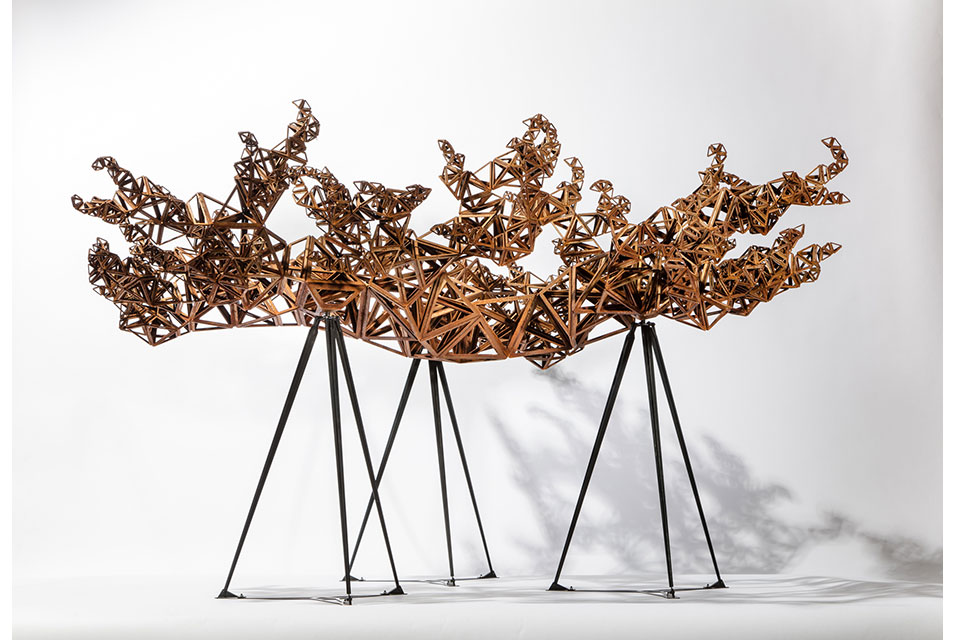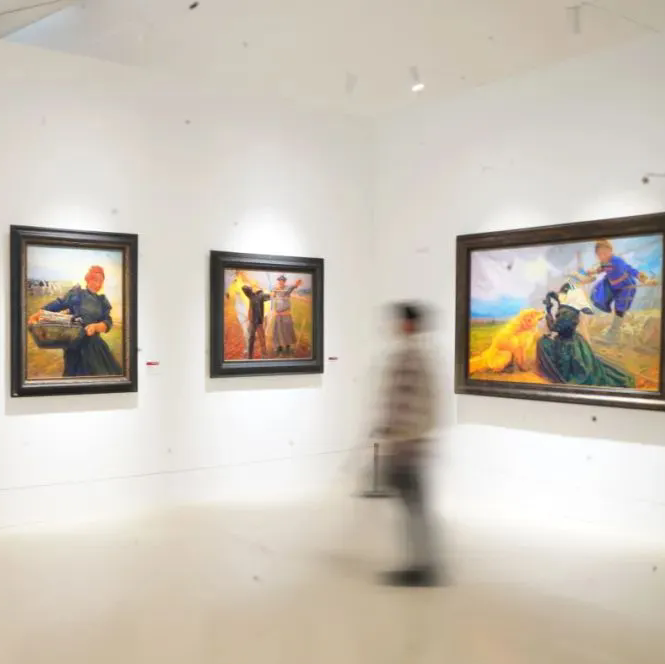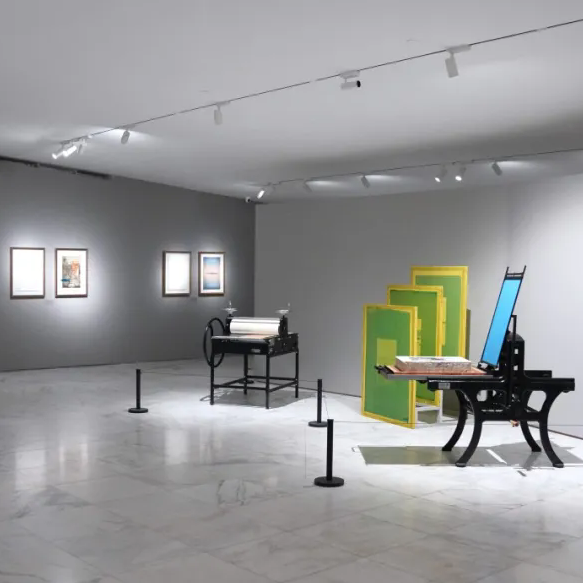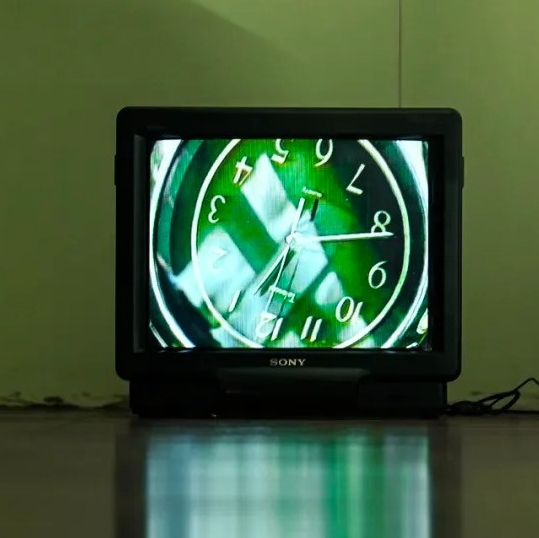
Installation View of Cascading Principles: Expansions within Geometry, Philosophy, and Interference, Courtesy of Oxford Mathematics.
The Mathematical Institute at Oxford University is hosting one of the UK’s largest exhibitions by the celebrated artist Conrad Shawcross, open to the public from 28 September. The exhibition, Cascading Principles: Expansions within Geometry, Philosophy, and Interference, brings together more than 35 sculptures realised by the artist over the last seventeen years. The artworks are placed in public and private areas, forming a web of relationships which emerge as the viewer moves through the building.

Conrad Shawcross at his east London studio CREDIT: Ben Quinto
Conrad Shawcross, who studied at Oxford University’s Ruskin School of Art, is the youngest current member of the Royal Academy of Arts and has a global reputation for specialising in mechanical sculptures based on philosophical and scientific ideas. Imbued with an appearance of scientific rationality, these explore subjects that lie on the borders of geometry and philosophy, physics, and metaphysics. Conrad Shawcross models scientific thought and reasoning within his practice. Drawn to mathematics, physics, and philosophy from the early stages of his artistic career, Shawcross combines these disciplines in his work. He places a strong emphasis on the nature of matter, and on the relativity of gravity, entropy, and the nature of time itself. Like a scientist working in a laboratory, he conceives each work as an experiment. Modularity is key to his process and many works are built from a single essential unit or building block. If an atom or electron is a basic unit for physicists, his unit is the tetrahedron.
![Schism (Château La Coste), [2020].jpg Schism (Château La Coste), [2020].jpg](/Uploads/UEditor/image/202210/6380040891705664065708093.jpg) Conrad Shawcross, Schism (Château La Coste), 2020, courtesy the artist.
Conrad Shawcross, Schism (Château La Coste), 2020, courtesy the artist.
Unlike other shapes, a tetrahedron cannot tessellate with itself. It cannot cover or form a surface through its repetition - one tetrahedron is unable to fit together with others of its kind. Whilst other shapes can sit alongside one another without creating gaps or overlapping, tetrahedrons cannot resolve in this way. Shawcross’ Schisms are a perfect demonstration of this failure to tessellate. They bring twenty tetrahedrons together to form a sphere, which results in a deep crack and ruptures that permeate its surface. This failure of its geometry means that it cannot succeed as a scientific model, but it is this very failure that allows it to succeed as an art work, the cracks full of broad and potent implications.
The show includes all Conrad's manifold geometric and philosophical investigations into this curious, four-surfaced, triangular prism to date. These include the Paradigms, the Lattice Cubes, the Fractures, the Schisms, and The Dappled Light of the Sun. The latter was first shown in the courtyard of the Royal Academy and subsequently travelled all across the world, from east to west, China to America.

Conrad Shawcross, Dappled Light of the Sun (Study IV - Prevailing Wind), 2018, courtesy the artist. At once materially heavy and conceptually light, geometrical and philosophical, 'The Dappled Light of the Sun' is a meticulously-constructed and extremely powerful structure. Photography: Benedict Johnson. Courtesy of the Royal Academy of Arts.
At once materially heavy and conceptually light, geometrical and philosophical, 'The Dappled Light of the Sun' is a meticulously-constructed and extremely powerful structure. Photography: Benedict Johnson. Courtesy of the Royal Academy of Arts.
The show also contains the four Beacons. Activated like a stained-glass window by the light of the sun, they are composed of two coloured, perforated disks moving in counter rotation to one another, patterning the light through the non-repeating pattern of holes, and conveying a message using semaphoric language. These works are studies for the Ramsgate Beacons commission in Kent, as part of Pioneering Places East Kent.
Cascading Principles: Expansions within Geometry, Philosophy, and Interference will be accompanied by a four-part symposium, with events taking place throughout the year of the exhibition. Researchers from Oxford Mathematics will be paired with artists and philosophers for talks that will foster cross-fertilisation of thought and creativity. The symposium series is organised in partnership with Modern Art Oxford and Ruskin School of Art, evoking the collaborative ethos of Conrad's artistic practice.
The exhibition Cascading Principles: Expansions within Geometry, Philosophy, and Interference is curated by Fatoş Üstek, and is organised in collaboration with Oxford Mathematics.
In arranging these works within the Mathematical Institute, Cascades places them in a dialogue with the intellectual work of its occupants and the ideas that originally inspired their creation.
Highlights of the exhibition include:
Schisms: an artistic demonstration of the failure of tetrahedrons to tessellate. This brings twenty tetrahedrons together to form a sphere, which results in a deep crack and ruptures that permeate its surface. This failure of its geometry means that it cannot succeed as a scientific model, but it is this very failure that allows it to succeed as an art work.
The four Beacons, each composed of two coloured, perforated disks that move in counter rotation to one another, patterning sunlight through the non-repeating pattern of holes, and conveying a message using semaphoric language.
The Lattice Cubes, each formed of forty-eight irregular tetrahedrons. These tetroids come together to form a rational working system, composed of pieces that can theoretically expand into infinity. The work alludes to the theory of the universe expanding from a single radiant point.
About the exhibition
Dates: Sep. 28, 2022 – Oct. 8, 2023
Venue: The Mathematical Institute at Oxford University
Courtesy of the Mathematical Institute at Oxford University.




























